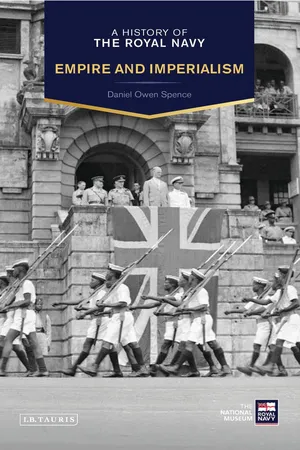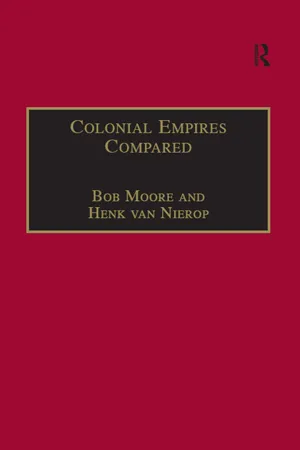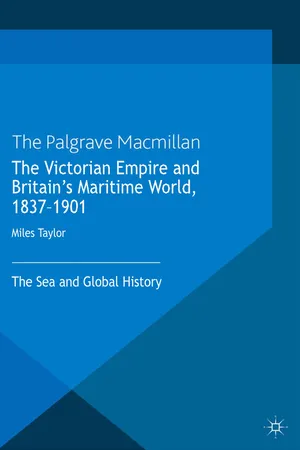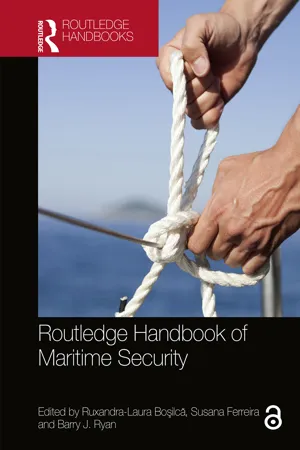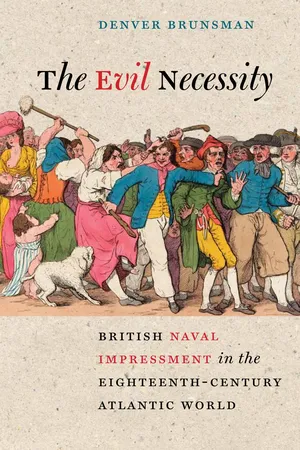History
English Maritime Empire
The English Maritime Empire refers to the period of British naval dominance and overseas expansion from the 16th to the 19th centuries. It was characterized by the establishment of colonies, trade routes, and naval supremacy, which allowed England to become a global maritime power. This empire played a significant role in shaping world history and influencing international trade and politics.
Written by Perlego with AI-assistance
Related key terms
6 Key excerpts on "English Maritime Empire"
- Claire Jowitt, Craig Lambert, Steve Mentz, Claire Jowitt, Craig Lambert, Steve Mentz(Authors)
- 2020(Publication Date)
- Routledge(Publisher)
4The cartography of the sea
Mapping England’s ‘mastery of the oceans’
Alistair S. MaeerThe so-called early modern ‘Age of European Expansion and Empire’ heralded momentous changes across the globe that still influence us today. Disparate peoples, cultures, flora, and fauna collided and unleashed a dizzying array of transformative experiences as peoples began to venture beyond their local shorelines and consistently interact with distant lands. This transformation was the product of a new embrace of the sea, one that increasingly led to claims of ‘mastery’ in the period 1400–1800. This mastery of the seas, and the related rise of commerce and empires, were the products of new maritime communities’ abilities to traverse the globe reliably. Maritime communities’ innovations in navigation, financial structures, and shipping, were the essential components of early modern European commercial expansionism and imperialism. Specifically, by the seventeenth century, the art of navigation and the act of traversing waterways increasingly became scientific endeavours with the use of charts. As a visual instrument for navigation constructed to depict coastlines, ports of call, and hazards, nautical cartography inherently reflects the willed perceptions of its makers and audience. Accordingly, as visual representations of perceived reality, cartographic sources (maps and charts) offer unrivalled opportunities to assess the evolving conceptions and conventions of peoples of the past. In effect, early modern nautical cartography is as much an embodiment of European mercantile and ministerial interests as it is an artistic and scientific artefact conveying ‘mastery’ of the sea.A comparative study of seventeenth-century European nautical cartography reveals that English overseas interests shifted from an emphasis on pragmatic mercantilism to a growing expression of territorial dominion and ambition, eventually emulating established European modalities of imperialism. Studying the evolution of English charting, by contrasting the relatively staid presentation of early seventeenth-century English charts to other contemporaneous European traditions, broadens Alison Games’ theory, primarily based on textual sources, of cosmopolitanism as an expression of pre-Restoration English attitudes.1- eBook - ePub
A History of the Royal Navy
Empire and Imperialism
- Daniel Owen Spence(Author)
- 2015(Publication Date)
- I.B. Tauris(Publisher)
Chapter 1 An Empire EmergesThough the political entity of ‘Great Britain’ would not emerge until the 1707 Act of Union, the intellectual foundation of a ‘British Empire’, built upon a strong Royal Navy, developed over the preceding centuries. The royal courts of Tudor England brought together scholars, wealthy aristocrats, entrepreneurs and sailors who petitioned the monarchy to back colonial ventures in the ‘New World’ by providing a navy that could protect their interests against Spanish and Portuguese rivals. From these networks emerged chartered trading companies who relied upon the expertise of naval captains to lead their colonising expeditions. In the process, unknown lands were discovered and settled, creating new resources and markets for the English economy. State intervention to stave off foreign competition strengthened the navy by stimulating shipbuilding and training seamen, allowing it to seize additional colonies from rival nations in wartime. A symbiotic relationship developed between the Royal Navy and the empire, as trade needed naval protection, and warships required safe harbours to refit and resupply with colonial men and resources, leading to annexation for strategic as well as economic purposes. Yet imperial and naval power was psychological as well as physical, and indigenous encounters gave rise to racial ideologies which justified British authority over indigenous peoples, both within the colonies and the ‘Senior Service’.The fifteenth and sixteenth centuriesBy the end of the Hundred Years’ War, England’s territories on the European mainland had been reduced to just the Pale of Calais. During 1436, following the siege of that city and with the English having fled Paris, the first English language political poem emerged. While the country’s aspirations for continental domination were dwindling, ‘The Libelle of Englyshe Polycye’, or ‘Little Book of English Policy’, was ‘exhortynge alle Englande to kepe the see enviroun’. It prophesised that as an island nation, England’s future prosperity would depend on it acquiring and maintaining overseas colonies, particularly Ireland, for which strength at sea would be crucial: ‘wyth alle your myghte take hede / To kepe Yrelond, that it be not loste’. Though unappreciated at the time, ‘The Libel’ marked the beginning of a naval intellectual tradition within English political debate, inspiring the writings of prominent navalists over succeeding centuries, such as Richard Hakluyt and Samuel Pepys, and used as recently as 2012 to emphasise the ongoing importance of naval power to Britain’s national and foreign policy.1 - eBook - ePub
Colonial Empires Compared
Britain and the Netherlands, 1750–1850
- Bob Moore, Henk van Nierop(Authors)
- 2017(Publication Date)
- Routledge(Publisher)
The use of the sea was an indispensable precondition for the existence of these empires and, in this sense at least, navy and empire must necessarily be closely linked. Within naval historiography, furthermore, there is a powerful tradition connecting the two. The founders of scholarly naval history in the late nineteenth century, who defined their subject in terms which are still widely accepted, were naturally interested in the connection between seapower and empire. For them it was important to show how the navy had made the empire, for it was self-evidently the empire which defined and established Britain’s greatness. Moreover writers like Sir John Laughton and Sir Julian Corbett were not simply studying naval history in a spirit of disinterested inquiry; they were engaged in a movement to reform the Royal Navy of their day in which historical research played an essential part. Naval history was a practical tool with which to open various neglected subjects, among them the defence of trade. They therefore stressed the navy’s role in the creation and defence of the empire. 4 Furthermore trade and imperial defence long continued to be the principal justifications argued for the size and structure of the Royal Navy, both abroad (for example at the interwar naval disarmament conferences) and at home. Only in recent years, with the British empire dismantled and the British merchant fleet greatly reduced, has it become possible to study British naval history with less distraction from current policy. This historiographical tradition has tended to encourage non-specialist historians in the impression that the navy always existed primarily to support overseas expansion and defend overseas trade. It is often assumed or implied that Britain had a long-term naval strategy of ‘blue-water’ expansion, enforced by the blockade of enemy naval ports, but steadily directed towards imperial ends - eBook - ePub
The Victorian Empire and Britain's Maritime World, 1837-1901
The Sea and Global History
- M. Taylor, M. Taylor(Authors)
- 2013(Publication Date)
- Palgrave Macmillan(Publisher)
8 The Victorian Maritime Empire in Its Global Context Jeremy BlackTime and space provide the matrix for history, both for the events of the past and for how we remember and present them. British naval power is no exception. Here the crucial variable is time in the shape of periodisation. British naval power, and its capacity to support a maritime empire, and indeed to help constitute an empire to which naval strength was crucial, looks assured if the period in question is Victoria’s reign, which lasted from 1837 to 1901.The situation is different, however, if the time span is varied, and notably if the period is lengthened at each end. 1815 to 1914 is the conventional chronology. It can be further broken down into phases. The first is little or no peer rival or competition to 1840. The second is that of the rise of France as a potential rival from 1840 through to the Crimean war. The third is additional concern about Russia in the 1880s, and further concern about rivals with the rise of the German navy in the 1900s.However, to go further back to 1796 is to find Britain vulnerable to the combined naval power of France, Spain and the Dutch, with rebellious sentiment also growing in sections of the fleet, and France able to challenge the British position in Ireland, which made the attitude of the Royal Navy particularly significant. To go forward to March 1917 is to find Britain exposed to unrestricted German submarine warfare, while the German High Seas Fleet remained undefeated, and Britain was not as yet provided with the added naval security that was to be gained when the USA joined the Allies.These crises can, of course, be re-examined. In 1796, opposing fleets lacked the fighting quality and organisational strength of the Royal Navy, as was to be demonstrated in successive British victories in 1797–98. In 1917, the declaration of German unrestricted submarine warfare - eBook - ePub
- Ruxandra-Laura Boşilcă, Susana Ferreira, Barry J. Ryan, Ruxandra-Laura Bo?ilc?, Susana Ferreira, Barry J. Ryan, Ruxandra-Laura Boşilcă, Susana Ferreira, Barry J. Ryan(Authors)
- 2022(Publication Date)
- Routledge(Publisher)
PART I Perspectives on Maritime SecurityPassage contains an image
1 Sea power in the Transformation of States and Overseas Empires (1500–1800)1
Benjamin de Carvalho and Halvard LeiraDOI: 10.4324/9781003001324-3In the words of Charles Tilly, “war made the state and the state made war” (Tilly 1975 , p. 42). Explicitly restricted to European states, to Tilly the wars in question were landed wars on the continent. However, it could well be argued that the pivotal moments in the development of the English polity between 1066 and 1940 occurred in 1588, when the Spanish Armada was beaten back at sea, and in 1757, when forces in the pay of the British East India Company beat a combined Indian and French force for the upper hand in the Indian subcontinent. Both of these battles relied on a capacity to project power on and across water, both of them involved violence-providers which were not strictly speaking state-controlled and both of them finally also were closely related to the English desire to establish a presence outside of the British Isles, to empire. The English trajectory has special traits, but it is not unique. In the Dutch case, the survival of the initial revolt against Habsburg rule depended on the Watergeuzen (the sea beggars) gaining control over the local sea and eventually also footholds on land, while the Vereenigde Oostindische Compagnie (VOC) was, for a time, probably the largest company in the world and vital cog in the machinery of the Dutch polity. Similar patterns, with variations in scale, can be found for the French, Danish and Swedish polities in the seventeenth and eighteenth centuries, while the Iberian polities followed somewhat different patterns, as did Russia, but all with an undeniable reliance on sea power and all with imperial traits. Here lies a number of paradoxes in the literature on state-formation.2 - eBook - ePub
Early American Histories
British Naval Impressment in the Eighteenth-Century Atlantic World
- Denver Brunsman(Author)
- 2013(Publication Date)
- University of Virginia Press(Publisher)
42Broad political support for an “empire of the seas” also reflected important ideological realities in eighteenth-century Britain. One legacy of the unremitting political turmoil of the seventeenth century was widespread support for a strong navy at the expense of the army. As Lord Halifax recognized in 1694, “The first article of an Englishman's political creed must be, that he believeth in the sea.”43 Dating to the era of Oliver Cromwell, works such as James Harrington's Commonwealth of Oceana (1656) associated standing armies in peacetime with despotic central governments and imperiled liberties, while navies defended against foreign invasions and tyranny. By the early eighteenth century, British statesmen, philosophers, and propagandists had all started to contrast the nation's sea-based “empire of liberty” with the territorial empires of antiquity, especially the Roman Empire, and from contemporary land-empires such as the Holy Roman Empire and Spain's colonial holdings in the Americas. Even if the idea of a benign maritime empire was never entirely true, it gave Britons a way to reconcile their country's ever-expanding colonial portfolio with its long identification with liberty.44These strategic and ideological considerations allowed the British navy to grow to a size and to conscript men on a scale that would never be permitted with the army. After 1688, the army could no longer impress soldiers by direct authority of the crown; instead, Parliament had to authorize set periods, usually no longer than a few months, for army impressment. In 1805, the American traveler Benjamin Silliman observed the differences between British army and naval impressment: “Englishmen would rise in arms, should the military impress for the army, citizens of every rank, from the fields, the streets, and public roads.” “One particular class of men,” Silliman continued, “seem to be abandoned by society, and relinquished to perpetual imprisonment, and a slavery, which, though honourable, cuts them off from most things which men hold dear.” The Royal Navy's popularity provided the political cover necessary for press gangs to operate.45
Index pages curate the most relevant extracts from our library of academic textbooks. They’ve been created using an in-house natural language model (NLM), each adding context and meaning to key research topics.

